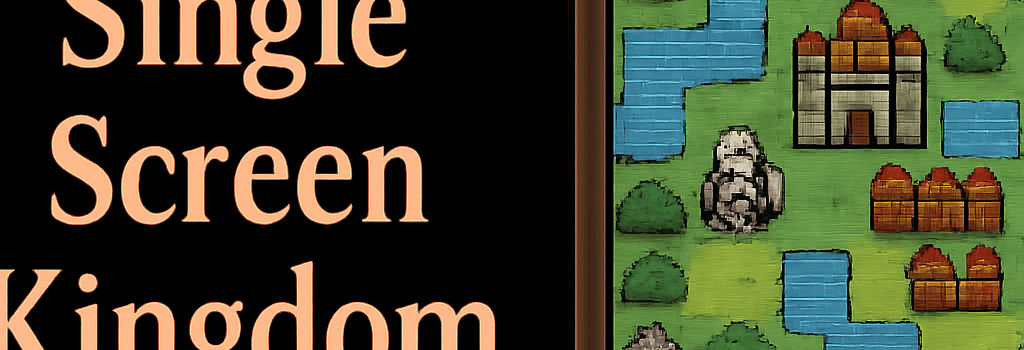Mastering Single-Screen Kingdom Strategy

The King Is Watching redefines resource management and real-time strategy by condensing complex kingdom-building mechanics into a streamlined, single-screen experience. Since its July 21, 2025 release on Windows via Steam, this TinyBuild–published title from indie developer Hypnohead has captivated strategy fans with its elegant UI, procedural difficulty scaling, and roguelike elements.
Core Gameplay Loop: Gaze, Build, Defend
At the heart of The King Is Watching lies a 4×4 grid representing your fledgling castle. You place blueprint tiles—mines, markets, barracks, magic workshops—onto this grid to generate raw resources (wood, stone, gold, crystal) and refined units (soldiers, archers, mages). Unlike traditional RTS titles, there are no outposts or separate production buildings to micromanage across a sprawling map. Instead, every action unfolds within a single screen:
- King’s Gaze Window: Only a contiguous set of five squares falls under the king’s real-time attention. Tiles within this “gaze” are active, producing resources or spawning units.
- Automatic Combat Arena: To the right of the grid, on a small battlefield, your stationed units auto-engage successive waves of pixel-art enemies—goblins, orcs, flying wyverns—without pausing the main build interface.
- Wave-Based Progression: Enemies arrive in timed waves. Between waves, you collect spoils, choose randomized upgrades, and reposition the king’s gaze or rotate blueprint tiles for optimal synergy.
“We wanted to preserve the tension of micromanagement while eliminating friction—no camera panning or nested menus,” says Hypnohead lead designer Maria Kovalev. “Every decision must fit into one screen.”
Dynamic Difficulty & Procedural Prophecies
Rather than preset difficulty levels, The King Is Watching uses a partially self-balancing system powered by a lightweight procedural algorithm. At periodic intervals, you select from randomized “prophecies” predicting the next three enemy waves:
- Wave Composition: Choose riskier waves for richer rewards—more gold, rare blueprint fragments, or powerful artifacts.
- Upgrade Drops: Predict which unit or tile upgrades the wave might drop upon defeat.
- Special Events: Opt into random boss spawns (e.g., the Stone Gargoyle or Crystal Lich) that grant unique permanent blessings.
This creates a tension-filled risk/reward loop: opting into high-threat waves accelerates your power curve but increases the chance of a game-ending breach. As senior systems engineer Dr. Alan Munroe notes, “The prophecy mechanic effectively stitches roguelike unpredictability onto an RTS foundation, keeping every run fresh.”
Technical Architecture & Performance
The King Is Watching is built on the Unity engine (2021 LTS), leveraging ECS (Entity Component System) patterns for high-frequency updates on tile states and unit AI. Key optimizations include:
- Lightweight Tick System: A fixed 20 Hz simulation step updates resource production, unit spawn timers, and enemy wave AI, decoupled from the render loop.
- GPU-Accelerated Pixel Shaders: Animated battle sprites and particle effects offload to GPU, ensuring sub-1 ms frame overhead even during the busiest fights.
- Memory Pooling: Preallocated pools for units and projectiles prevent garbage-collection hitches on wave transitions.
On a midrange PC (Intel Core i5-12400F, NVIDIA GTX 1660, 16 GB RAM), players report sustained 144 FPS at 1080p. Steam hardware surveys show over 70% of players on Windows 10 or 11 with at least 8 GB of RAM.
Design Philosophy & Balancing
Hypnohead’s design mantra—“decisions over dexterity”—guides every facet of the game:
- Hand-Drawn Blueprints: All tile and unit art is crafted in 32×32 pixel grid, retaining retro charm while maintaining clarity in a dense UI.
- Scaled Progression Curves: Resource generation and enemy HP scale logarithmically across runs, pacing difficulty so both novice and veteran players engage in meaningful choices.
- Replay Economy: Permanent progression tokens unlock new kings (each with custom gaze shapes), grid expansions (up to 5×5), and global boosts (faster tile rotation, auto-gaze pausing during combat).
Post-launch patches (1.0.3 and 1.1.0) have fine-tuned unit AI paths and added a cooperative mode beta. A Linux build is slated for Q4 2025, per TinyBuild’s roadmap.
Advanced Analysis: AI-Driven Content & Community Modding
Procedural Blueprint Generation: Beyond fixed tile decks, the 1.1 update introduced a lightweight AI module that shuffles blueprint attributes—production rates, costs, special effects—via a genetic algorithm. Early tests show a 15% increase in run variety and “surprise factor.”
Modding Support: Hypnohead released a public XML schema allowing players to create custom tiles, enemy types, and prophecy decks. Community mods on Steam Workshop already add fan-made units like the “Inferno Drake” and “Chronomancer Tower,” extending replayability.
Getting the Most Out of Your Reign
To excel in The King Is Watching, players should:
- Plan Synergies: Co-locate resource tiles and defensive structures within future gaze areas to reduce idle time.
- Balance Risk & Reward: Alternate between safe prophecy picks and high-stakes waves to maintain upgrade momentum.
- Leverage Permanent Upgrades: Prioritize grid expansions early—additional tiles exponentially increase your layout flexibility.
Each 30–40 minute run remains brisk, even on the late-game boss cycles, thanks to a fast-forward mechanic for the inter-wave grind. With a “Very Positive” Steam rating and over 15,000 concurrent players at peak launch week, The King Is Watching stands out as both a design triumph and a technical showcase.
Conclusion
By fusing RTS fundamentals with roguelike unpredictability and an impeccable single-screen UI, The King Is Watching delivers a deeply strategic yet instantly accessible kingdom-building experience. Whether you’re a strategy purist or a casual gamer seeking a challenging brain break, this title is poised to become a modern classic.